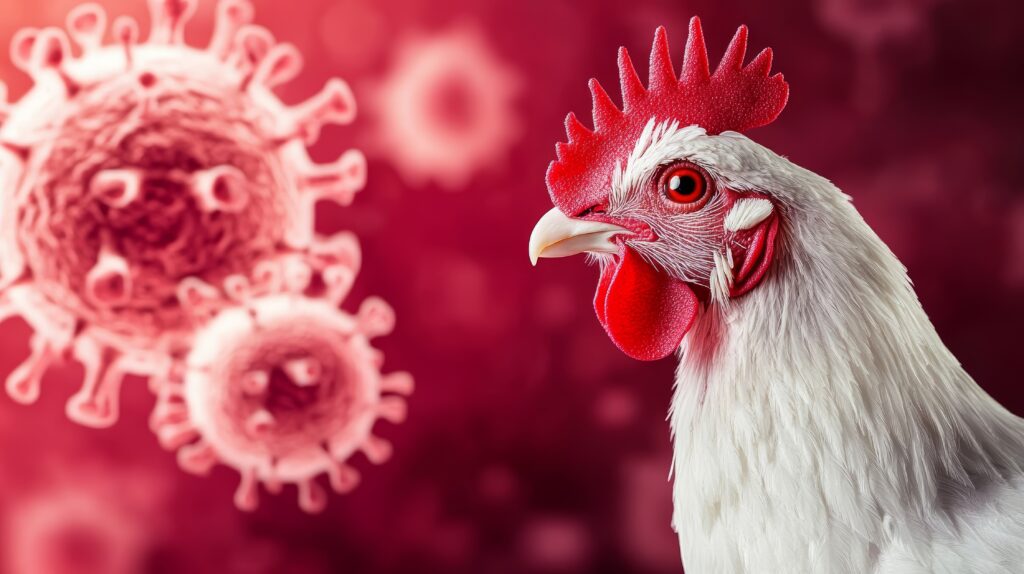The global outbreak of highly pathogenic avian influenza A (H5N1) underscores the critical importance of proactive and integrated health strategies. With its zoonotic potential, the H5N1 virus affects diverse animal populations and poses significant risks to human health, ecosystems, and economies worldwide. At Promega, we are dedicated to equipping researchers and public health professionals with the tools they need to navigate and address these complex challenges.
Understanding H5N1 and Its Impact
A Global Challenge
The H5N1 outbreak has led to the depopulation of over 300 million birds across 108 countries, spanning five continents. The virus has infected over 500 bird species and at least 70 mammalian species, including endangered California condors and polar bears (1). The virus has had significant economic repercussions, particularly in the poultry industry, with 168 million birds culled in the United States to date (2). Recent human infections, primarily among farm workers, highlight the need for continued vigilance and robust surveillance systems.

Cross-Species Spillover
In the US, H5N1 has spread beyond poultry to other domesticated species including dairy cattle and cats (2). The U.S. Department of Agriculture (USDA) has responded to the growing threat of H5N1 with strengthened regulatory measures. On December 6, 2024, the USDA issued a Federal Order mandating additional testing and reporting of H5N1 in livestock and milk (3). This builds on an earlier order from April 2024, which required the testing of lactating dairy cows before interstate shipment and mandatory reporting of any positive results (4). Fortunately, pasteurization effectively inactivates the virus, providing reassurance about food safety (5). These measures are critical for safeguarding the dairy supply chain and mitigating public health risks.
Human Health Implications
In human cases, H5N1 infections have primarily caused mild illnesses such as conjunctivitis in individuals exposed to infected animals, with no evidence of human-to-human transmission to date (6). However, the first U.S. death attributed to H5N1 highlights the importance of ongoing vigilance (7). While the current public health risk is low, the CDC is closely monitoring the situation and collaborating with states to track individuals exposed to infected animals. CDC’s flu surveillance systems are actively monitoring for H5 bird flu activity in people to ensure early detection and response.
Disease Preparedness
To enhance preparedness, the U.S. Department of Health and Human Services has recently allocated $306 million for avian influenza monitoring and outbreak prevention efforts, highlighting the importance of early detection and response systems (8). Additionally, investments are being made to bolster vaccine stockpiles, underscoring the need for proactive measures to protect both livestock and human health (9). Dr. Mandy Cohen, former director of the U.S. Centers for Disease Control and Prevention (CDC), emphasized mRNA as a preferred platform for H5N1 vaccines due to its rapid development and distribution capabilities (10).
The Role of the One Health Initiative
The global response to H5N1 underscores the principles of the One Health Initiative, which emphasizes the interconnectedness of human, animal, and environmental health. The One Health approach is vital in addressing zoonotic diseases like H5N1, as the virus impacts multiple sectors simultaneously. Collaborative efforts to improve animal health, safeguard food systems, and monitor environmental reservoirs contribute to protecting public health at large.
- Human Health: Rapid and accurate detection, alongside advancements in research and vaccine development, is essential for managing zoonotic spillover and strengthening public health readiness. In a 2025 study performed at the National Institute of Allergy and Infectious Diseases, National Institutes of Health, the Promega LDH-Glo Cytotoxicity Assay1 was used to measure cell death in human lung organoids when comparing replication of contemporary and historical H5N1 viruses.
For up-to-date information on H5N1 human cases in the US, visit H5 Bird Flu: Current Situation | Bird Flu | CDC - Animal Health: Early detection in avian and livestock populations is essential for outbreak prevention. Promega’s nucleic acid extraction kits and testing systems—validated for challenging matrices like milk—help veterinarians and researchers identify pathogens with precision.
Learn more about animal detections in the US at 2022–2024 Detections of Highly Pathogenic Avian Influenza. - Environmental Health: Environmental reservoirs, such as wastewater, can serve as surveillance points for tracking viral spread. The Promega GoTaq® Enviro Wastewater FluA, FluB, SC2 System1 offers an early warning mechanism for outbreaks, aiding public health efforts.
Stay informed about environmental surveillance at Wastewater Data for Avian Influenza A(H5) | National Wastewater Surveillance System | CDC
Promega Solutions in Action
Promega’s portfolio empowers scientists and researchers to tackle health challenges efficiently and effectively:
- Reliable Diagnostics: High-quality nucleic acid extraction kits and master mixes support accurate diagnostics across various sample types, from milk to tissue samples. Our automated systems like the Maxwell® RSC 481 used with the Maxwell® RSC SimplyRNA Tissue Kit (AS1340) 1, support high-throughput needs and ensure efficiency and scalability. Read more about how Our Maxwell® Travels from Spain to Antarctica to Help Stop the Avian Flu Virus – Promega Connections
- Supporting Vaccine Development and Preparedness: The USDA and CDC have identified self-amplifying mRNA vaccines as a preferred platform for combating H5N1. Promega supports vaccine development with cell-based assays like the CellTiter-Glo® Luminescent Cell Viability Assay1 to assess vaccine potency and toxicity. Additional tools, such as the RiboMax™ Large Scale RNA Production Systems1, are applicable for vaccine research and development, including large-scale mRNA production for therapeutic applications. Promega provides tailored solutions, from specialized reagents to scalable manufacturing processes, ensuring our partners can respond quickly to emerging health crises.
- Innovative Research Tools: The Viability PCR Reagent System1 uses proprietary technology to differentiate and amplify nucleic acid from only live cells or intact viruses. This system offers a distinct advantage in achieving accurate detection by excluding signals from dead or inactivated organisms.
1For Research Use Only. Not for Use in Diagnostic Procedures.
A Commitment to Sustainability and Science

At Promega, our commitment extends beyond science to include sustainability and community well-being. By integrating renewable energy and reducing waste in our operations, we align our practices with the broader goals of the One Health Initiative, creating solutions that are both impactful and environmentally responsible
Partnering for a Resilient Future
The fight against H5N1 demonstrates the need for collaboration and innovation. At Promega, we are proud to stand alongside researchers, public health agencies, and industry leaders in advancing solutions that protect health across all domains. Together, we can build a more resilient and interconnected future.
References
For more about our One Health solutions and how we can support your work, visit the Promega Corporation website.
- Avian flu reported in 108 countries across five continents, says UN health agency | UN News
- 2022–2024 Detections of Highly Pathogenic Avian Influenza
- Federal Order Requiring Testing for and Reporting of Highly Pathogenic Avian Influenza (HPAI) in Livestock
- Federal Orders | Animal and Plant Health Inspection Service
- Testing of Retail Cheese, Butter, Ice Cream, and Other Dairy Products for Highly Pathogenic Avian Influenza in the US – PubMed
- Highly Pathogenic Avian Influenza A(H5N1) Virus Infections in Humans | New England Journal of Medicine
- First H5 Bird Flu Death Reported in United States | CDC Newsroom
- US to award $306 mln for bird flu monitoring and preparedness | Reuters
- US to build new stockpile of bird flu vaccine for poultry | Reuters
- Scientists Are Racing to Develop a New Bird Flu Vaccine | TIME
Latest posts by Promega (see all)
- One Health and H5N1: Promega’s Commitment to Holistic Solutions - April 8, 2025
- Overcoming qPCR Inhibitors: Strategies for Reliable Quantification - March 13, 2025
- Celebrating Creativity and Innovation: The 2025 Promega Employee Art Showcase - February 4, 2025

Thank you for writing this excellent piece. Here is the latest news (March 2025) about the newly identified virulent strain H7N9!! FYI from Los Angeles Times March 19. https://www.latimes.com/environment/story/2025-03-19/bird-flu-developments-new-strain-discovered-and-research-on-immunity#:~:text=A%20new%20strain%20of%20a,chickens%20are%20raised%20for%20breeding.